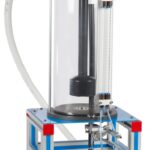Question No. 1
What is mechanical engineering?
Answer:
Mechanical engineering is the discipline that applies the principles of engineering, physics and materials science for the design, analysis, manufacturing, and maintenance of mechanical systems. It is the branch of engineering that involves the design, production, and operation of machinery and tools.
Question No. 2
What is the difference between Technology and Engineering?
Answer:
Answer: Engineering is application of science. Technology shows various methods of Engineering. A bridge can be made by using beams to bear the load, by an arc or by hanging in a cable; all shows different technology but comes under civil engineering and science applied is laws of force/load distribution.
Question No. 3
What is the difference between Speed and Economic Speed?
Answer:
The rated speed tells us about the maximum speed which can be achieved by a vehicle or some other machine but the economical speed means the speed limit at which the machine works efficiently with least consumption of fuel. e.g. in normal bikes(not racing),the maximum speed limit shown on speedometer is up to 120 kmph but companies always advice their customers to drive such bikes at around 60 kmph to have maximum mileage.
Question No. 4
What causes hardness in steel? How heat treatment alters properties of steel?
Answer:
The shape and distribution of the carbides in the iron determines the hardness of the steel. Carbides can be dissolved in austenite is the basis of the heat treatment of steel. If steel is heated above the A critical temperature to dissolve all the carbides, and then cooled, suitable cooling through the cooling range will produce the desired size and distribution of carbides in the ferrite, imparting different properties.
Question No. 5
What is the difference between isotropic and anisotropic materials?
Answer:
If a material exhibits same mechanical properties regardless of loading direction, it is isotropic, e.g., homogeneous cast materials. Materials lacking this property are anisotropic.
Question No. 6
What are orthotropic materials?
Answer:
It is a special class of anisotropic materials which can be described by giving their properties in three perpendicular directions e.g. wood; composites.
Question No. 7
What is view factor?
Answer:
View factor is dependent upon geometry of the two surfaces exchanging radiation.
Question No. 8
Explain difference between fissile and fertile materials.
Answer:
The materials which can give nuclear fission e.g. U 35, Pu 39, U 33 are fissile materials. Fertile material itself is not fissionable, but it can be converted to a fissionable material by irradiation of neutrons in a nuclear reactor.
Question No. 9
Mention two types of dislocations.
Answer:
Dislocation refers to a break in the continuity of the lattice. In edge dislocation, one plane of atoms gets squeezed out. In screw dislocation the lattice atoms move from their regular ideal positions.
Question No. 10
What is Powder Technology?
Answer:
Powder technology is one of the ways of making bearing material. In this method metals like bronze, Al, Fe are mixed and compressed to make an alloy.


